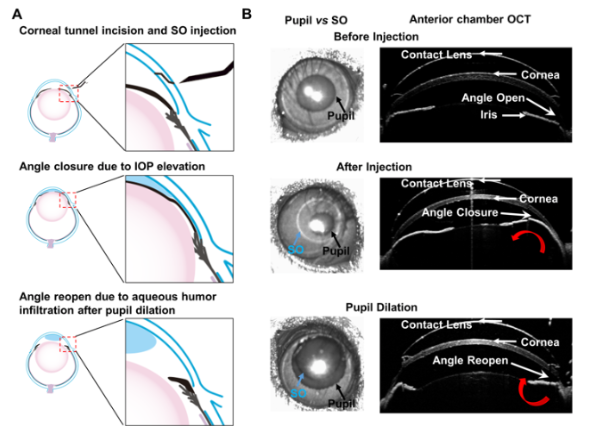Docket #: S19-013
Glaucoma Animal Models Based on Silicone Oil-Induced Mild/Chronic and Severe/Acute Reversible Ocular Hypertension
Stanford researchers developed glaucoma mouse models for studying neuroprotection treatments and molecular mechanism of IOP-related neurodegeneration. The Stanford procedure requires only one injection of silicone oil in the anterior chamber to induce pupillary block and ocular hypertension with severe RGC loss, optic nerve degeneration and vision deficits that faithfully resemble clinical secondary glaucoma. Ocular hypertension is reversible by simply removing the silicone oil. Two additional variations of this model simulate two distinct glaucoma types. The first is a chronic model produced by high frequency pupillary dilation after SO-induced pupillary block, which shows sustained moderate IOP elevation and corresponding slow, mild glaucomatous neurodegeneration. The second, an acute model created by no pupillary dilation, shows a greatly elevated IOP and severe inner retina degeneration at an early time point.
These simple, inducible and reversible models will standardize ocular hypertension-induced pathology and support studies of pathogenetic mechanisms and of selection of neuroprotectants for glaucoma. With continued research, these models can be extended to other animal species with minimal modifications.

Figure description - Silicone oil-induced ocular hypertension under-detected (SOHU) mouse model. (A) Cartoon illustration of SO intracameral injection, pupillary block, closure of the anterior chamber angle, and reopening of the angle of anterior chamber after pupil dilation. (B) Representative anterior chamber OCT images of SOHU eyes in living animals showing the relative size of SO droplet (blue arrow) to pupil (black arrow) and the corresponding closure or opening of the anterior chamber angle before and after pupil dilation. Red curved arrow indicates the direction of aqueous humor flow.
Stage of Research
Applications
- Animal model for evaluating treatment for glaucoma
- Animal model for investigating IOP-related neurodegeneration
- Animal model for evaluating neuroprotectants for glaucoma, other optic neuropathies with RGC degeneration and other CNS neurodegenerative diseases
Advantages
- Mimics secondary post-operative glaucoma
- Recapitulates phenotypes of two major glaucoma forms
- Simple, inducible and reversible
- Effective in vivo method to test neuroprotective therapies by targeting neuronal endoplasmic reticulum stress
- Produces glaucoma pathology quickly (80% of retinal ganglion cell death at 5-8 weeks)
- Sustains IOP elevation for a long period of time without permanent damage to the eye
- Does not require special equipment or repeat injections
Publications
- Fang, Fang, et al. "Chronic mild and acute severe glaucomatous neurodegeneration derived from silicone oil-induced ocular hypertension." Scientific Reports 11.1 (2021): 1-14.
- Zhang J, Li L, Huang H, Fang F, Webber HC, Zhuang P, Liu L, Dalal R, Tang PH, Mahajan VB, Sun Y, Li S, Zhang M, Goldberg JL, Hu Y. Silicone oil-induced ocular hypertension and glaucomatous neurodegeneration in mouse. Elife. 2019 May 15
- Zhang, J., Fang, F., Li, L., Huang, H., Webber, H. C., Sun, Y., Mahajan, V. B., Hu, Y. A Reversible Silicon Oil-Induced Ocular Hypertension Model in Mice. J. Vis. Exp. 2019 (153)
- Jie Zhang, Yang Hu. Comparing silicone oil-induced ocular hypertension with other inducible glaucoma models in mice. Neural Regenerative Research (2020)
Related Links
Similar Technologies
-
Mouse Strain C57BL/6J-Tg (ACTB-DDAH1) S12-334Mouse Strain C57BL/6J-Tg (ACTB-DDAH1)
-
System and methods for optogenetic stimulation and inhibition of pain S13-278System and methods for optogenetic stimulation and inhibition of pain
-
CRISPR/Cas9 Knock-in Mice S15-174CRISPR/Cas9 Knock-in Mice